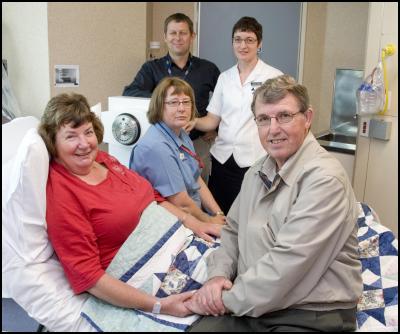Improved service for oncology patients
Improved service for oncology patients
New
technology reduces treatment times

Click to enlarge
Caption: Diana Clark following her brachytherapy treatment with (left to right) Dr Scott Babington, Registered Nurse Ann Bradley, Senior Radiation Therapist Carolyn Kardos and Diane’s husband Bruce Clark.
A new machine at Christchurch
Hospital’s Oncology Service will reduce treatment times
for gynaecological cancers to 10 minutes and patients can
again be treated in the South Island. From mid-2008 some
women have had to travel to other centres due to the ageing
of the department’s existing LDR machine and
unavailability of replacement components.
“With the commissioning of our new High Dose Rate (HDR) brachytherapy machine they will no longer have to travel to Wellington, Hamilton or Auckland,” said Carolyn Kardos, Brachytherapy Co-ordinator.
Treatments began on Monday 15 February. Treatment times are also significantly reduced with the new HDR machine, Carolyn said.
“Until now women requiring treatment for gynaecological cancers have been isolated in the treatment room for one to three days. With the new HDR machine, treatment times are approximately 5-10 minutes each. That makes a huge difference to these women.”
Patients do, however, need to have several treatments spread over a number of days or weeks. Brachytherapy is a form of radiation treatment in which a radioactive source is placed in or close to a specific site, for example the vagina or cervix, for a calculated amount of time.
The Christchurch Hospital Oncology Service provides the brachytherapy service for the entire South Island which currently means treating approximately 40 women per annum for a variety of gynaecological malignancies.
“Another major advantage of the new technology is that it will not only be able to treat these patients with greater accuracy but it could also be used for a range of other sites such as prostate, breast, oesophagus, lung and skin cancers,” said Scott Babington, senior radiation oncologist.
“With HDR more precise treatment is possible, using dedicated planning software and MRI (Magnetic Resonant Imaging) and/or CT scans to accurately identify the area to be treated. This means a greater chance of hitting the target, with improved rates of cure.”
Christchurch Hospital has a long history of brachytherapy, with patients first being treated in 1923. From 1968 until 2002 manual handling of radioactive sources for brachytherapy was done in a dedicated suite at the “old” Christchurch Women’s Hospital, Ward 2.
In 2003 the Oncology service purchased a second hand Low Dose Rate (LDR) Selectron, which no longer required staff to manually handle the radioactive sources. This was housed in the old Christchurch Women’s Hospital as before and was transported to a dedicated suite in the new women’s hospital when it opened.
ENDS


 NZ Association of Scrabble Players: Watch New Zealand’s 2025 Scrabble Championship Live
NZ Association of Scrabble Players: Watch New Zealand’s 2025 Scrabble Championship Live Waipapa Taumata Rau: Daytime Boosts Immunity, Scientists Find
Waipapa Taumata Rau: Daytime Boosts Immunity, Scientists Find NZ Songwriters Trust: Winners Announced At Country Music Honours
NZ Songwriters Trust: Winners Announced At Country Music Honours NZ Principals Federation: Principals Describe Budget As Bitter Sweet
NZ Principals Federation: Principals Describe Budget As Bitter Sweet GfK Radio: Radio Listening Tops 3.5M Weekly Listeners
GfK Radio: Radio Listening Tops 3.5M Weekly Listeners  Jacob Douglas Motorsport: Douglas Heads To The Oval After Breakthrough Victory
Jacob Douglas Motorsport: Douglas Heads To The Oval After Breakthrough Victory